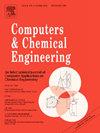Structural constraint reduction in process simulator-based optimisation: Leveraging the P-graph framework
IF 3.9
2区 工程技术
Q2 COMPUTER SCIENCE, INTERDISCIPLINARY APPLICATIONS
引用次数: 0
Abstract
In superstructure-based process synthesis, the same superstructure can be modelled with different levels of detail. Models can be characterised into three main categories: high-level aggregate models, shortcut models, and detailed rigorous models. If a detailed modelling level is required, process simulators offer a reliable and rigorous modelling environment. In this context, process simulator-based superstructure optimisation may be performed by postulating the superstructure: (1) in an external optimisation environment, or (2) as a flowsheet in the process simulator itself. This work is focused on the latter option.
To reduce the tedious mathematical writing of the logical constraints required to guarantee the structural coherence of a sequence of unit operations, a P-graph-based framework is proposed in the current work. The developed framework consists of three algorithms. The first algorithm transforms the superstructure flowsheet into a P-graph. The second algorithm gets process sub-flowsheets from the superstructure by searching for active units corresponding to a set of decisions made, for example, by an optimiser. The third one checks structural feasibility by verifying that the resulting process satisfies the five axioms of the original P-graph framework and two additional connectivity tests proposed in this work.
The methodology is tested on two different examples based on Organic Rankine Cycles. The first case study, based on a published article, consists in applying the methodology to build a superstructure implicitly equivalent to the original logic constraints formulation. The second case study is presented to implement the proposed framework into a Combined Heat and Power Cycle optimisation problem.

基于过程模拟器的优化中的结构约束减少:利用p图框架
在基于上层建筑的过程综合中,同一上层建筑可以用不同层次的细节进行建模。模型可以分为三大类:高级聚合模型、快捷模型和详细严格模型。如果需要详细的建模级别,过程模拟器提供可靠和严格的建模环境。在这种情况下,基于过程模拟器的上层结构优化可以通过假设上层结构:(1)在外部优化环境中,或(2)作为过程模拟器本身的流程图来执行。本文主要关注后一种选择。为了减少保证单元操作序列结构一致性所需的逻辑约束的繁琐数学写作,在当前的工作中提出了一个基于p图的框架。所开发的框架包括三个算法。第一种算法将上层建筑流程图转换为p图。第二种算法通过搜索与一组决策相对应的活动单元(例如,由优化器),从上层结构获得过程子流程图。第三部分通过验证结果过程是否满足原p图框架的五个公理和本工作中提出的两个附加连通性检验来检查结构可行性。基于有机朗肯循环的两个不同实例对该方法进行了测试。第一个案例研究基于一篇已发表的文章,包括应用该方法构建一个隐含等同于原始逻辑约束公式的上层建筑。提出了第二个案例研究,以实现所提出的框架到一个热电联合循环优化问题。
本文章由计算机程序翻译,如有差异,请以英文原文为准。
求助全文
约1分钟内获得全文
求助全文
来源期刊

Computers & Chemical Engineering
工程技术-工程:化工
CiteScore
8.70
自引率
14.00%
发文量
374
审稿时长
70 days
期刊介绍:
Computers & Chemical Engineering is primarily a journal of record for new developments in the application of computing and systems technology to chemical engineering problems.
 求助内容:
求助内容: 应助结果提醒方式:
应助结果提醒方式:


